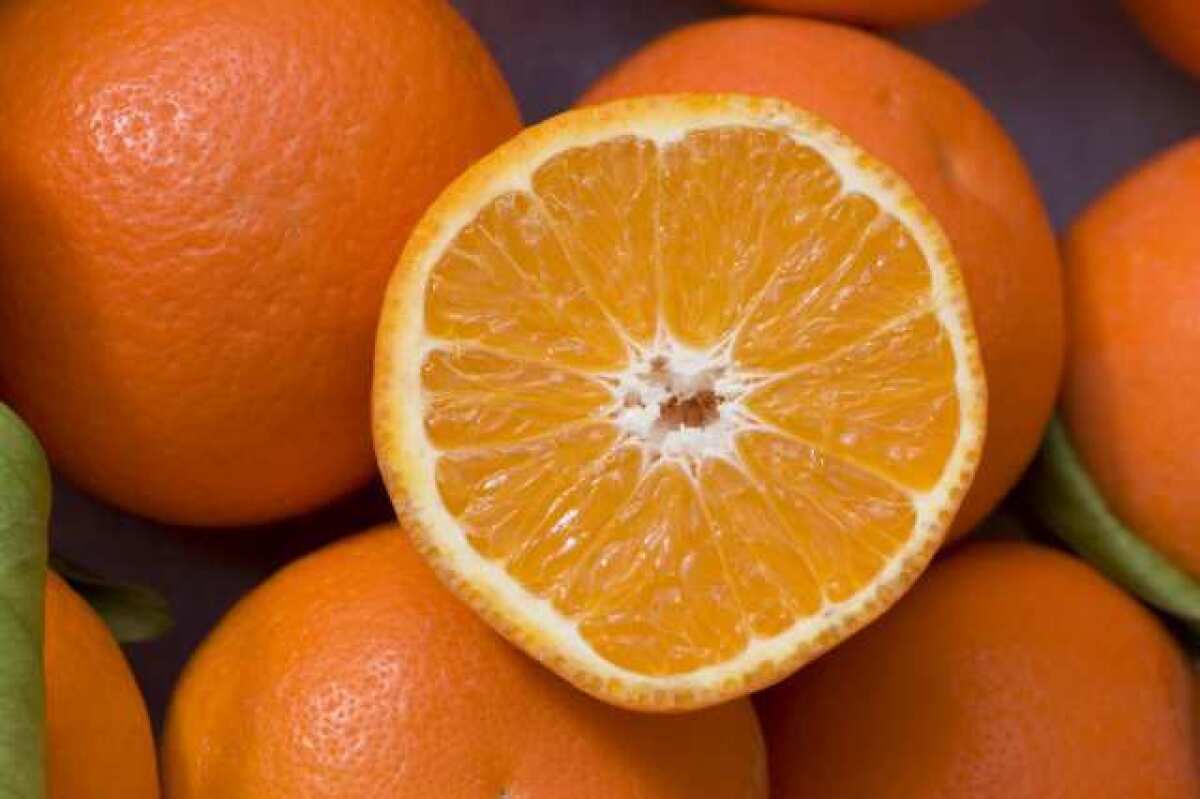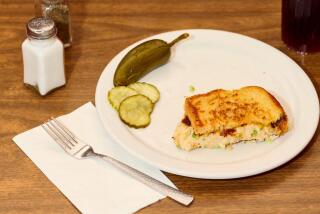Market Watch: At Ventura Downtown farmers market, Minneola tangelos and cauliflower

The Ventura Downtown farmers market, the oldest and largest farmers market in Ventura County, has remained remarkably stable over the last decade, with a good mix of local growers, including many small and backyard farmers. It benefits from its location in a growing area rich in vegetable, berry and citrus farms, and from the experience and integrity of its longtime manager, Karen Wetzel Schott, who does a good job keeping out peddlers masquerading as farmers. The ambience is especially relaxed and family-friendly.
Several growers at the market had Minneola tangelos, one of the most distinctive and intensely flavored citrus varieties, now in prime season from Southern and Central California groves. The fruit is instantly recognizable by its knobby neck at the stem end and its fine, smooth, red-orange rind. The flesh is so tender and juicy that in Florida, where this juiciness is accentuated (and Minneolas often are called Honeybells), some marketers include a straw and a bib with their gift boxes.
Minneola originated in Florida as a hybrid of two distinguished parents, Duncan grapefruit and Dancy tangerine, made in 1911 by the great citrus scientist Walter T. Swingle of the U.S. Department of Agriculture, who was hoping to come up with new orange-like fruits resistant to citrus canker, a bacterial disease. To describe the fruit type, a new word, “tangelo,” was coined as a composite of “tangerine” and “pomelo” (at the time horticulturists were trying to push “pomelo” as the preferred name for grapefruit). Introduced in 1931 and named after a town just west of Orlando, Minneola derived rich aromatics from its tangerine parent and tartness, but no bitterness, from its grapefruit parent.
The rind is peelable, but the segment walls are delicate, making it difficult to pull apart the segments without spilling juice, so I prefer to slice the fruit into six or eight longitudinal sections. Fruits can vary from moderately seedy to seedless. The juice is delicious fresh but does not keep well.
Cultivation in California started slowly but now amounts to more than 5,000 acres, spread around the state: in the desert and the San Joaquin Valley, which start harvest in December and January, respectively; and inland southern districts, which begin a few weeks later. Minneolas picked too early in the season from each area can be attractively orange yet quite tart, so it’s important for farmers and shoppers to wait for the fruit to ripen properly.
In Ventura County the best-suited area for tangelos is the eastern Santa Clara Valley, around Fillmore and Piru, where summer heat helps sweeten the fruit. Local tangelos will be good from now until April or May, after which they become too soft and puffy even for farmers market vendors.
At the Ventura market, excellent local Minneolas are offered by Jerry Joske of Fillmore, who primarily sells there, and Rancho de Trinidad of Piru, originally named Tangelo Rancho when it was owned by the Warren family. Trinidad also sells at the Thousand Oaks, Santa Clarita, Brentwood and Beverly Hills markets.
Cauliflower
Cauliflower is available year-round from cooler coastal districts like Oxnard and Santa Maria, but further inland in Moorpark, where Underwood Family Farms grows, the heads separate into loose, smaller curds when it’s hot, so the season runs from November to May.
Until the last decade or so, most of the varieties grown commercially were white or off-white, but new colored varieties have become increasingly popular in recent years, particularly at farmers markets. Underwood has green Vitaverde, pigmented with chlorophyll; Orange Burst, colored with beta-carotene; and Graffiti, which derives its purple tint from anthocyanins. I find the purple and orange kinds, particularly, are not only pretty to look at, but are more tender, sweet and flavorful than standard white varieties.
These colored varieties supposedly retain their coloration when cooked, but in my experience, much of the color drains away from purple kinds when boiled or steamed. To better preserve the color and amplify the flavor, I prefer to cook the florets by coating them with olive oil in a bowl and roasting them at 375 degrees until they soften slightly but are not singed, about 25 minutes.
Underwood sells at a dozen farmers markets aside from Ventura, including Pasadena (Saturday), Camarillo, Encino and Hollywood.
Ventura Downtown farmers market, Santa Clara and Palm streets, Saturdays 8:30 a.m. to noon.
More to Read
Eat your way across L.A.
Get our weekly Tasting Notes newsletter for reviews, news and more.
You may occasionally receive promotional content from the Los Angeles Times.






